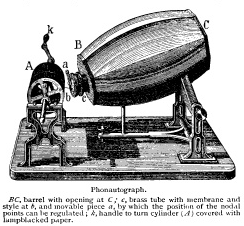Tuesday, April 15, 2008
Vova poked you. Do you want to return Vova's poke?
I'm seriously considering joining the Russian Facebook clone, ВКонтакте.ру . The only thing keeping me back at this point is the fear that this would mean that I'd be procrastinating in two languages.
Tuesday, April 8, 2008
Old School Lo-Fi
I've mentioned here previously that I'm somewhat preoccupied with sound, music, and noise. For this reason, even though it's been mentioned in several venues and at length, I feel like adding my own voice to the chorus of audiotechnogeeks who are singing the praises of a team of researchers who managed to reconstruct a ten-second audiorecording from the year 1860.
It sounds marvelously, marvelously awful:
There was an internet rumor (and a pretty funny episode of The X Files) a few years ago about how the voice of Jesus Christ had been captured in the soft clay of a spinning dish on a potter's wheel near Jesus. This is, of course, ridiculous... in its details. But the general idea that sound s could be recorded prior to the advent of sound playback technologies is actually not so far fetched.
Enter this ingenious little creation, the phonautograph:

If you want the whole story behind the phonautograph, you should really pick up a copy of Jonathan Sterne's brilliant book The Audible Past. In a nutshell, though, this invention recorded sound waves as scratches on a membrane. I know, it doesn't seem all that big a deal these days, but in the middle of the 19th century, it was no small feat to document sound visually.
As it happens, one day the phonautograph was used to record a person singing "Au Clair de la Lune." About one hundred and fifty years later, some very smart people with computers realized that they could reconstruct the sound of that voice by carefully reading that phonautograph recording and cleverly compensating for the uneven speed of the hand that cranked the machine. The result is ten seconds of almost unrecognizable singing... and it's music to my ears.
It sounds marvelously, marvelously awful:
There was an internet rumor (and a pretty funny episode of The X Files) a few years ago about how the voice of Jesus Christ had been captured in the soft clay of a spinning dish on a potter's wheel near Jesus. This is, of course, ridiculous... in its details. But the general idea that sound s could be recorded prior to the advent of sound playback technologies is actually not so far fetched.
Enter this ingenious little creation, the phonautograph:

If you want the whole story behind the phonautograph, you should really pick up a copy of Jonathan Sterne's brilliant book The Audible Past. In a nutshell, though, this invention recorded sound waves as scratches on a membrane. I know, it doesn't seem all that big a deal these days, but in the middle of the 19th century, it was no small feat to document sound visually.
As it happens, one day the phonautograph was used to record a person singing "Au Clair de la Lune." About one hundred and fifty years later, some very smart people with computers realized that they could reconstruct the sound of that voice by carefully reading that phonautograph recording and cleverly compensating for the uneven speed of the hand that cranked the machine. The result is ten seconds of almost unrecognizable singing... and it's music to my ears.
Subscribe to:
Comments (Atom)